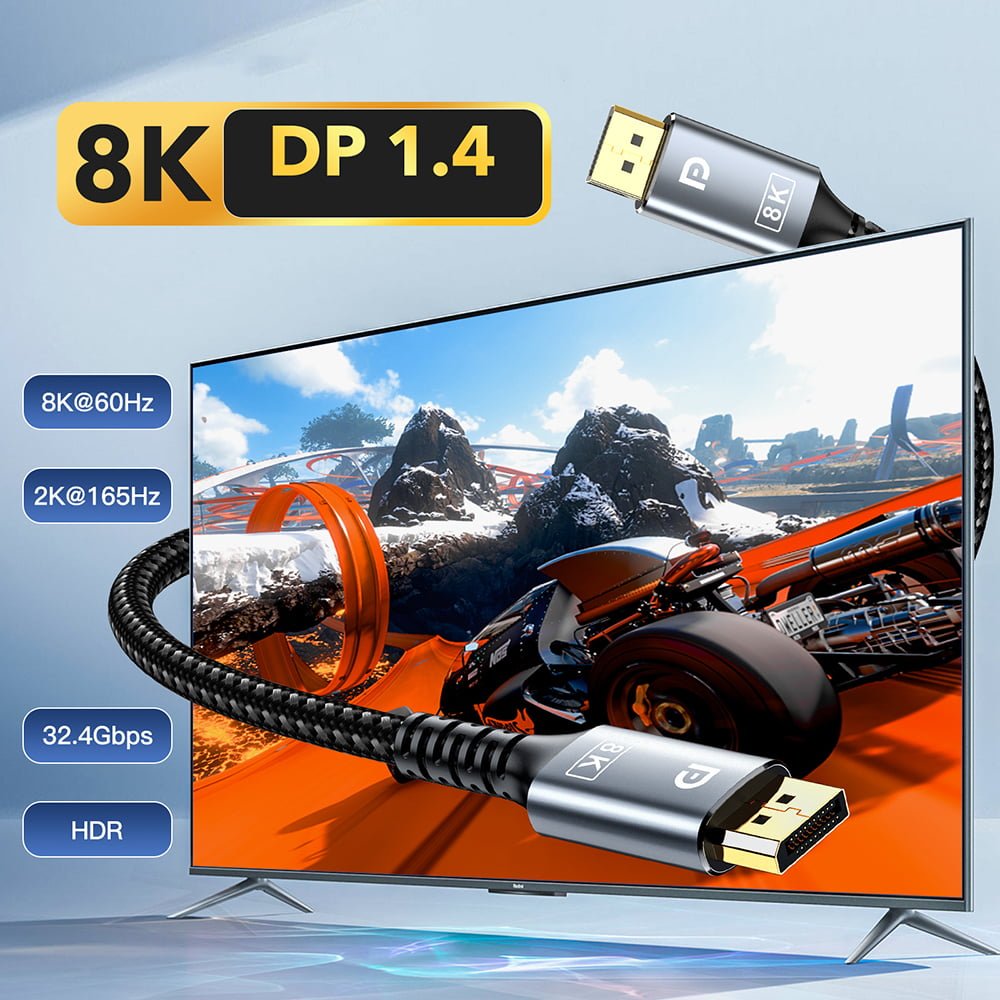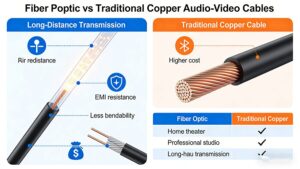Уже много лет, DisplayPort является предпочтительным высококлассным соединением для передачи данных и звука для геймеров и работников, использующих мониторы с разрешением и высокой частотой обновления, например 4K при 144 Гц. Благодаря более высокой скорости передачи данных, чем HDMI 2.0Но она гораздо лучше справляется с более сложными потоками данных, и так будет и в 2022 году. HDMI 2.1 Возможно, они смогут составить конкуренцию, но поддерживающие их устройства все еще трудно найти, поскольку они ограничены high-end графическими процессорами и дисплеями.
В разработке находится и новый стандарт DisplayPort. DisplayPort 2.0 - но кроме этого, DisplayPort 1.4 это лучшее, что вы можете получить. Несмотря на то, что ему уже много лет, он все еще может похвастаться лучшими характеристиками и спецификациями среди разъемов. Только самые современные альтернативы могут противостоять ему и даже надеяться на конкуренцию.
Что такое DisplayPort 1.4?
DisplayPort 1.4 это цифровой интерфейс дисплея, разработанный Ассоциацией стандартов видеоэлектроники (VESA). Стандарт DisplayPort 1.4 был впервые опубликован в марте 2016 года. Хотя он не ввел никаких новых режимов передачи и не увеличил доступную полосу пропускания или скорость передачи данных, он сохранил сильные позиции с DisplayPort 1.3. Максимальная общая пропускная способность DisplayPort 1.4 составляет 32,4 Гбит/с, а максимальная общая скорость передачи данных - 25,92 Гбит/с. Этого достаточно для обработки потока 4K UHD с частотой до 120 Гц и цветом 24 бит/пикс или дисплея 5K с частотой до 60 Гц и цветом 30 бит/пикс. Он даже поддерживает 8K видеоНо только на частоте до 30 Гц из-за высоких требований к пропускной способности.

Использование DisplayPort 1.4 очень простое. Подключите кабель DisplayPort между выходом устройства и входом монитора/телевизора. Включите питание, выберите нужный вход, и все заработает.
DisplayPort 1.4 играет важную роль в различных сценариях, где необходима передача видео и аудио высокого разрешения. Геймеры в значительной степени полагаются на него благодаря его способности обеспечивать плавное и четкое изображение, которое может идти в ногу с быстрым темпом современных игр, обеспечивая захватывающие впечатления без замираний и задержек. Высокая производительность делает его основным инструментом для профессионалов, таких как дизайнеры и редакторы, где точность изображения имеет решающее значение.
DisplayPort 1.4 также широко используется в офисах и образовательных учреждениях для подключения компьютеров к проекторам или мониторам. Это обусловлено его совместимостью с дисплеями высокого разрешения, что позволяет проводить четкие презентации и обмениваться контентом. Кабель Dp 1.4 - это универсальное, высокопроизводительное соединение для игр, развлечений, профессиональной деятельности и образования - идеальное решение для надежных и высококачественных дисплеев.
DisplayPort 1.4: преимущества и усовершенствования
Кабели обладают рядом преимуществ и усовершенствований, которые делают их востребованной технологией отображения информации. DisplayPort 1.4 (март 2016 года): Пропускная способность 32,4 Гбит/с, скорость передачи данных 25,92 Гбит/с, поддержка высоких разрешений/частоты обновления. Ключевые: DSC 1.2 (кодирование без потерь для высокого разрешения/HDR) - 4K 120 Гц (30-битный HDR) или 8K 60 Гц.
Кроме того, DisplayPort 1.4 обеспечивает поддержку Двухрежимные адаптеры DVI и HDMIчто позволяет пользователям подключать дисплеи HDMI или DVI к источнику DisplayPort. Кроме того, улучшена поддержка метаданных HDR10 и функция прямой коррекции ошибок (FEC), обеспечивающая бесшумную передачу данных. Благодаря этим усовершенствованиям пользователи могут наслаждаться улучшенным качеством изображения и бесперебойной связью при использовании DisplayPort 1.4.
DisplayPort 1.4 также значительно продвинулся в области аудио. Аудио: 768 кГц→1 536 кГц, 8→32 канала - улучшенный звук для профессионалов, что делает DP 1.4 желанным.
Стоит ли покупать DisplayPort 1.4?
DisplayPort 1.4 - это самая востребованная технология DisplayPort. Но вы можете спросить себя, стоит ли DisplayPort 1.4 того? Нужен ли мне DisplayPort 1.4?
Ответ на эти вопросы неоднозначен, поскольку зависит от конкретного случая использования и потребностей. Если DSC 1.2 и расширенный звук (из DP 1.4) принесут вам пользу, то стоит потратиться.
Если вы более типичный пользователь, которому нужны игры, фильмы или работа на мониторе с частотой 60 Гц, DisplayPort 1.2 совершенно нормально. Пропускная способность DisplayPort 1.2 составляет 21,6 Гбит/с по сравнению с 32,4 Гбит/с на DisplayPort 1.4но для обычных пользователей этого более чем достаточно. Одним из главных недостатков DP 1.2 является отсутствие поддержки HDR.
Для игр с высокой частотой обновления (120 Гц+) или редактирования в высоком разрешении используйте пропускную способность DisplayPort 1.4 - 32,4 Гбит/с. Вам необходимо убедиться, что все оборудование (монитор, источник и кабель) поддерживает DisplayPort 1.4. К счастью, Кабели DisplayPort 1.4 по сходной цене с Кабели DP 1.2 поэтому выбрать его достаточно просто - достаточно взглянуть на характеристики продукта. Большинство кабелей DP 1.4 заявляют о максимальном разрешении 8K, DP 1.2 - 4K. DP 1.4 обратно совместим с 1.2, что делает его кабели отличным вариантом для будущего.
Убедитесь, что вы покупаете Кабели DisplayPort 1.4 из такого авторитетного источника, как Фоюнь. Кабели DisplayPort компании Foyun в большинстве своем сертифицированы по стандарту VESA и отвечают строгим требованиям ассоциации. Варианты: короткие пассивные или длинные активные (максимум 24 фута) кабели DisplayPort. Ознакомьтесь с предложениями Foyun.
Часто задаваемые вопросы по DisplayPort 1.4
Является ли DisplayPort 1.4 лучше, чем HDMI?
DisplayPort 1.4 часто считается лучшим для компьютерных игр и многомониторных систем благодаря более высокой максимальной пропускной способности 32,4 Гбит/с и поддержке технологии сжатия потоков дисплея (DSC), которая позволяет использовать более высокие разрешения и частоты обновления без потери качества изображения. Он также поддерживает высокий динамический диапазон (HDR) и несколько независимых видеопотоков, что делает его идеальным для современных конфигураций мониторов. Дополнительно, DisplayPort 1.4 включает такие функции, как коррекция ошибок вперед и гибкая передача пакетов метаданных, обеспечивая повышенное качество видео- и аудиосигнала. HDMI широко распространен в потребительской электронике, но DisplayPort 1.4 обеспечивает более высокую производительность для нужд высшего уровня.
Что лучше для игр - DisplayPort 1.4 или HDMI 2.1?
Выбор между DisplayPort 1.4 и HDMI 2.1 для игр зависит от конкретных требований пользователя. HDMI 2.1 обладает более высокой максимальной пропускной способностью 48 Гбит/с, поддерживает 4K при 120 Гц и 8K при 60 Гц с HDR, что делает его подходящим для новейших игровых консолей и высококлассных игровых комплексов. Он также включает такие функции, как переменная частота обновления (VRR) и автоматический режим низкой задержки (ALLM), что улучшает игровой процесс. DisplayPort 1.4, однако, лучше подходит для компьютерных игр благодаря функции DSC и нескольким потокам для современных мультимониторных систем.









